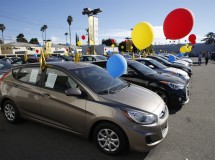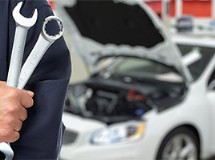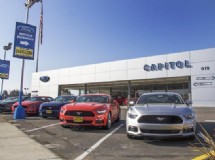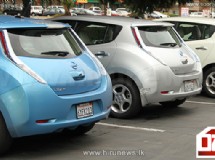So my wife's 2000 Grand Voyager is a great minivan. It still looks good, and runs perfectly. The only sign of age on this vehicle, inside or out, is the faded, yellowed headlights. They were completely fogged over, I couldn't even see the bulbs inside. Sure, they still illuminated the road, but they could obviously be doing a better job if they weren't faded like that. I decided this was something that needed to be corrected. I searched online and found dozens of headlight repair kits. Some had good reviews, some had awful review comments. I decided this was something I could probably find at an auto parts store.
I bought a kit. The instructions said I need a drill. I have drill. It's not a small drill, and it's probably way more than required for this job, but it's the only one I have. I begin by sanding, as instructed. The drill is moving all over the place as I am having trouble controlling the spinning disc while sanding. I follow instructions using the different types of sandpaper and wipes for cleaning as I go along. Half way through this process I realize that I have no where near the supplies needed to finish this job! I barely have enough to finish the one headlight, and as you have probably noticed, Grand Voyagers generally have two headlights! So I carry on.
I finished, or thought I had, the sanding process. I managed to scuff the paint in two places around the headlight while trying to control and move the drill. Apparently, the electric drill also melted the lens in a couple of places, creating a brown crust stuck on the lens which required considerable effort to remove.
Per the instructions, I wiped/cleaned the lens off to prepare for the sealant. The sealant consist of a 1/4 ounce foil tube, to be applied with the corner of a paper towel. Well, the paper towel promptly absorbed a majority of the sealant. The rest I applied to the one headlight. The results were mixed. Parts of the lens actually looked OK, other parts were not. I am not sure if I sanded too much, or not enough. At any rate the sandpaper is now used up and the sealant is completely gone.
Instead of investing in another kit and even more of my time, I decided to see what a professional repair would cost. It started out rather expensive. The dealer simply would NOT repair them, but they would gladly sell me new headlight units, and charge me $80/hr to install them. An autobody shop would repair them for $150. A much better deal, but I had to leave the car with them. I was told I would probably not get the car back the same day.
I then found a mobile service in my area that specializes in headlight restorations. They are called LensMedic.net and they operate in Memphis TN. They charge $79, and the come to you to make the repairs. I was told most repairs take less than an hour. I booked my appointment for the next day, on their website.
They came to my home and made the repairs. Indeed, it took about an hour. The headlights look great! Even the one that I worked on with the kit. The technician told me they do plenty of follow up repairs for DIY'ers. I am not surprised.
If you have the tools and the experience to do these kinds of repairs, you can save a few dollars. If you don't have the proper tools, or the patience, or the time, you should definitely consider having a professional do the repair for you. If you can find a mobile service in your area, such as LensMedic.net, even better.
I bought a kit. The instructions said I need a drill. I have drill. It's not a small drill, and it's probably way more than required for this job, but it's the only one I have. I begin by sanding, as instructed. The drill is moving all over the place as I am having trouble controlling the spinning disc while sanding. I follow instructions using the different types of sandpaper and wipes for cleaning as I go along. Half way through this process I realize that I have no where near the supplies needed to finish this job! I barely have enough to finish the one headlight, and as you have probably noticed, Grand Voyagers generally have two headlights! So I carry on.
I finished, or thought I had, the sanding process. I managed to scuff the paint in two places around the headlight while trying to control and move the drill. Apparently, the electric drill also melted the lens in a couple of places, creating a brown crust stuck on the lens which required considerable effort to remove.
Per the instructions, I wiped/cleaned the lens off to prepare for the sealant. The sealant consist of a 1/4 ounce foil tube, to be applied with the corner of a paper towel. Well, the paper towel promptly absorbed a majority of the sealant. The rest I applied to the one headlight. The results were mixed. Parts of the lens actually looked OK, other parts were not. I am not sure if I sanded too much, or not enough. At any rate the sandpaper is now used up and the sealant is completely gone.
Instead of investing in another kit and even more of my time, I decided to see what a professional repair would cost. It started out rather expensive. The dealer simply would NOT repair them, but they would gladly sell me new headlight units, and charge me $80/hr to install them. An autobody shop would repair them for $150. A much better deal, but I had to leave the car with them. I was told I would probably not get the car back the same day.
I then found a mobile service in my area that specializes in headlight restorations. They are called LensMedic.net and they operate in Memphis TN. They charge $79, and the come to you to make the repairs. I was told most repairs take less than an hour. I booked my appointment for the next day, on their website.
They came to my home and made the repairs. Indeed, it took about an hour. The headlights look great! Even the one that I worked on with the kit. The technician told me they do plenty of follow up repairs for DIY'ers. I am not surprised.
If you have the tools and the experience to do these kinds of repairs, you can save a few dollars. If you don't have the proper tools, or the patience, or the time, you should definitely consider having a professional do the repair for you. If you can find a mobile service in your area, such as LensMedic.net, even better.
SHARE






































